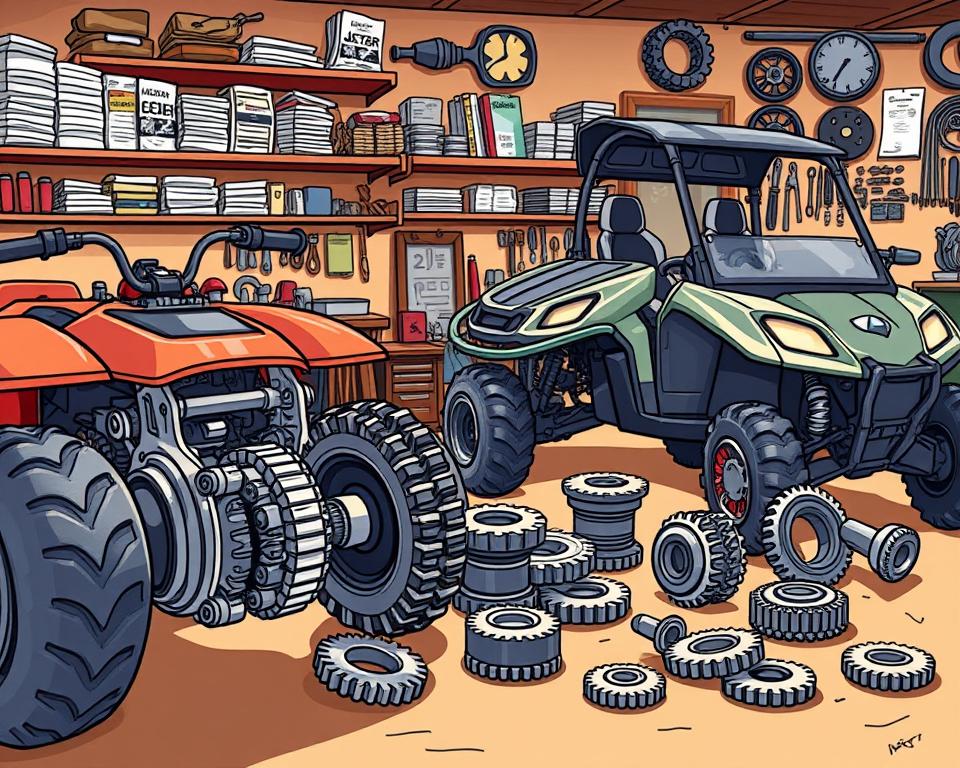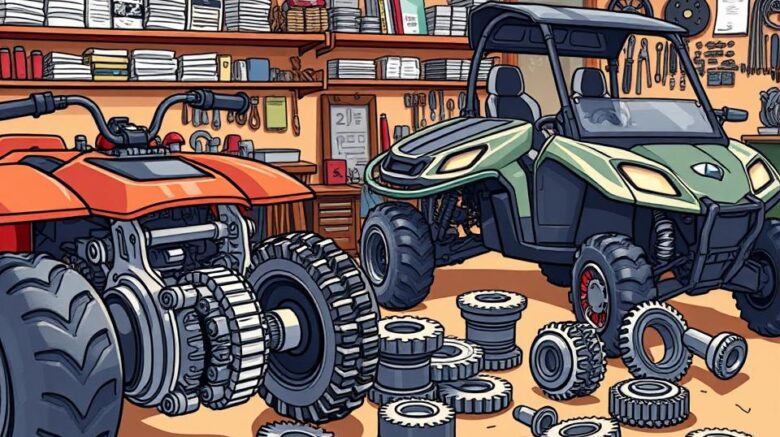Must-Have ATV Off-Road Safety Checklist
It might surprise you to discover nearly some 450,000 ATV-related injuries are treated in U.S. emergency rooms each year? This alarming figure highlights the need for safety and preparedness in off-road adventures. Use this Essential ATV Off-Road Checklist to ensure every ride is safe and fun. It covers everything from rocky trails to sand dunes. Equipped with top safety gear plus atvparts necessities, you’ll ride safer and with more confidence.
Important Notes
- Prioritize safety by using the Essential ATV Off-Road Checklist for optimal preparation.
- Your gear list is critical for staying protected off-road.
- Keep your ATV running smoothly with routine care.
- Stay fueled and hydrated for peak performance.
- Master your GPS and maps to stay on track.
- Be ready for unexpected weather changes to stay comfortable during your adventure.
- Always carry essential tools and recovery kits for on-trail repairs and emergencies.
Understanding the Importance of Safety Gear
Off-road adventures require a strong focus on safety. ATVs deliver thrills—and risks. Safety gear is essential for protecting riders from accidents and injuries. A full gear check means a safer outing.

Essential Protective Gear
Maximizing protection involves several key items:
- Riding Helmets: Only DOT-certified lids will protect your skull.
- Eye Protection: Protect your vision with wraparound goggles.
- Gloves: Wear durable gloves for better grip and hand protection.
- Footwear: Wear sturdy boots that cover the ankles to prevent injuries.
- Protective Armor: Aggressive riders should consider body armor for extra security.
- Neck Protection: Neck braces can help reduce the risk of spinal injuries.
Emergency Preparedness
Don’t overlook your emergency kit. A well-packed kit might save your life. Key items to include are:
- First aid kit
- Multi-tool
- Tire repair kits
- Portable air compressors
- Emergency blankets
- Whistles
- Matches
ATV Equipment for Optimal Performance
Gear choices affect how well your ATV runs. Don’t leave home without these ATV must-haves. Use this maintenance checklist to keep your ride healthy.
Must-Have ATV Equipment
- Durable Tires: Choose tires that grip mud, sand, and rocks.
- Cargo Systems: Mount racks or bags to carry your gear safely.
- Fuel Reservoir: Opt for a robust tank to avoid drips and dry runs.
- First Aid Kit: Prepare for emergencies with a well-stocked first aid kit for immediate attention if needed.
Regular Maintenance for Longevity
Routine care keeps breakdowns at bay. Regular inspections should encompass:
- A clean air filter = a happy engine.
- Lubricating the chain to ensure optimal performance.
- Test your brakes on every pre-ride check.
This ATV maintenance checklist is essential for keeping your vehicle in peak condition and ready for adventure.
The Essential ATV Off-Road Checklist
Preparing for a ride is more than just hopping on your ATV. A quick check prevents major headaches. Each pre-ride inspection step requires attention to detail. Spend a few minutes now for peace of mind later.
Pre-Ride Inspection Basics
Your pre-ride look-over sets the tone for safety. This quick evaluation helps riders identify and address issues before they start. Key elements to check include:
- Tire pressure and tread condition
- Fluid levels such as oil and fuel
- Brakes and controls functionality
- Operational lights and horn
- Chain or driveshaft integrity
T-CLOC Inspection Method
T-CLOC covers every critical system. Tires, Controls, Lights, Oil/Fuel, Chain—don’t miss a spot. This method ensures all critical areas are covered:
| Inspection Area | Checklist Items |
|---|---|
| Tires and Wheels | Check tire pressure, inspect tread depth, look for damage |
| Controls | Test brakes, throttle, and clutch for smooth operation |
| Lights | Ensure headlights, brake lights, and indicators are functioning |
| Oil and Fuel | Check oil level, inspect for leaks, and fill fuel tank |
| Chain/Driveshaft | Examine for wear, proper tension, and lubrication |
Spending a few minutes on this ATV maintenance checklist can make rides safer and more enjoyable. Prevent roadside repairs with a fast check.
Hydration and Nutrition for Long Rides
Long ATV rides require careful attention to hydration and nutrition. Dehydration slows reaction and focus—pack extra water. Carry extra water to prevent fatigue and keep energy levels up during the adventure. The right snacks are also key for maintaining stamina on the trail.
Importance of Staying Hydrated
Drink often—don’t wait for thirst. It’s important to drink water consistently, not just when thirsty. Hydration bladders track consumption at a glance.
High-Energy Snacks to Pack
Choosing the right snacks is vital for extended ATV rides. Pack portable, long-shelf treats. Some ideal choices include:
- Protein bars
- Nut mixes
- Dried fruits
- Beef jerky
Snack smart for sustained energy. Ensure to pack a variety to keep your energy levels high and your taste buds satisfied.
Navigation Tools for Off-Roading Adventures
Exploring uncharted territory demands reliable navigation tools. A dependable nav setup means you’ll always find your way.
Advanced GPS Systems
High-end GPS units guide you through the wild. GPS should work without cell service and last all day. Garmin, TomTom, and others make GPS units built for bumps and dust.
Traditional Navigation Aids
Don’t ditch old-school compasses and maps. Maps won’t die when batteries do. Map-and-compass know-how keeps you in control. Blend modern and classic for ultimate wayfinding.
Communication Equipment for Safety
Stay in touch even off the grid. Using reliable ATV communication gear is vital for safety. Talking to your team prevents misadventures.
For seamless communication among group members, a quality two-way radio is highly recommended. Opt for radios rated for miles of reach. They allow for real-time updates on any changes or hazards. When choosing two-way radios, look for models with:
- Rugged, waterproof design to resist the elements
- Extended run-time for extended trips without needing a recharge
- Multiple channels for clear communication without interference
Always include comms in your gear list. Group comms save time and reduce risk. When reception is zero, your radio still works. Clear comms = better rides.
Self-Rescue Gear for ATV Riders
Don’t be caught unprepared—pack rescue gear. Self-rescue gear for ATVs is key to handling challenges on your own. Being self-sufficient elevates confidence and safety.
Winches and Recovery Kits
A winch can drag you out of any rut. Combine winch power with the right accessories. Recovery kits usually include:
- Tow straps
- D-rings
- Recovery boards
- Gloves
Knowledge plus gear equals true self-rescue. Be ready for anything the trail throws at you.
Trail Recovery Essentials
Winches are just the start; several trail recovery essentials are also critical for off-road adventures. These include:
| Equipment | Purpose |
|---|---|
| Recovery Straps | Used for towing or pulling ATVs out of tight situations. |
| Shovel | Helps clear obstacles and dig out vehicles when stuck. |
| Traction Mats | Provides grip under tires in muddy or slick conditions. |
| Portable Air Compressor | Enables quick tire inflation after deflating for better traction. |
Be the rider who never gets stranded. Practice rescues so you’re ready when it counts.
Staying Adaptable: Preparing for Weather Changes
Trail weather can change in minutes. Your comfort and safety depend on proper weather prep. An ATV gear checklist must include weather gear to cover all bases.
Dress in layers to stay comfortable. A dry base keeps you cozy. Then, add insulating layers like fleece or wool that can be removed as needed. Finish with a rain-and-wind jacket. Adapt to cold, heat, or storms easily.
Weather-Appropriate Clothing
- Rain Shells: Stay dry when the sky opens up.
- Ventilated Off-Road Pants: Allows for ventilation while protecting against wet conditions.
- UV Gear: Sun-blocking shirts and hats prevent overexposure.
- Cold-Weather Gloves: Warm gloves maintain dexterity in chill.
Quality weather gear is a must for a great off-roading experience. Stay focused on the trail, not on being wet or cold.
Tools for On-Trail Repairs
Your toolkit can make or break your day on the trail. It’s vital to carry reliable ATV repair tools. Fix flats and loose bolts in minutes.
Must-Have Tools and Kits
Keep these tools handy at all times. Pack only the essentials—no junk. Critical ATV repair tools might include:
- Tire irons for changing flat tires
- Pliers for gripping and cutting
- Wrenches for various sizes of bolts and nuts
- A multi-tool for versatility
- Spare items such as spark plugs and electrical wire
- Duct tape for quick fixes
Having these tools readily available boosts confidence and autonomy while exploring off-road trails.
Basic Emergency Supplies
In addition to essential tools, packing basic emergency supplies for ATV is vital. These supplies help ensure your safety in challenging situations:
- First aid kit for injuries
- Flashlight with extra batteries for night-time visibility
- Emergency whistle for signaling assistance
- Reflective triangles or flares to warn other riders
- Water and high-energy snacks for sustenance
Preparedness significantly impacts your off-roading experience. Never leave home without them.
To Summarize
Success and enjoyment in off-road adventures depend on thorough preparation. Check off each item and pick reputable brands. Be set for rocks, sand, mud—anything.
With the right protective gear, navigation tools, and communication equipment, you’re set for safe riding. Prep wisely for peak thrills and protection. Embrace excitement, ditch the doubts.
Gear up, stay sharp, and savor every off-road second. Your ride’s story begins with good prep. By following the Essential ATV off-road checklist, you’re set for an incredible adventure in the great outdoors.
FAQ
What must an ATV safety checklist cover?
Start with a DOT helmet and sturdy goggles. Gloves, suitable footwear, and body armor are also necessary. Consider a neck brace for extra safety. Also bring a medical kit and adaptable multi-tool.
How do I keep my ATV in top shape?
To maintain your ATV, regularly check air filters and lubricate the chain. Always test your brakes before a ride. Routine care prolongs longevity and readiness.
What is included in T-CLOC?
T-CLOC inspects five critical systems. It includes checking Tires and Wheels, Controls, Lights, Oil and Fuel, and Chain/Driveshaft. Using T-CLOC guarantees safe, smooth rides.
How much water should I bring on an ATV trip?
Carrying more water than you think you’ll need is essential. Proper hydration wards off exhaustion. Hydro packs let you drink without stopping.
How to stay on course off-road?
For navigation, invest in an advanced GPS system designed for off-road use. Also carry a compass and laminated maps.
Why carry two-way radios?
Radios prevent isolation when cell fails. Areas with limited cell service highlight the need for reliable two-way radios.
Essential recovery gear for off-road?
Be ready with winch and recovery essentials. Have straps, shackles, mats, and gloves on hand.
Tips for weather readiness off-road?
To prepare for sudden weather changes, wear layered clothing that can be adjusted as temperatures change. Waterproof gear is necessary to stay dry during unexpected rain. Wear sun-blocking fabrics and hats.
What tools should I pack for on-trail repairs?
Carry essential wrenches, pliers, and irons. Have spares and tape for quick fixes.
